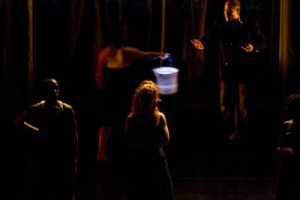I got to see the most amazing dance/theater performance on Thursday night at Danspace Project @ St. Marks Church in the East Village. Once inside the historic St. Marks Church, we were transported into the world of David Dorfman and his agile cast of dancers.
Dorfman is known for making dance/theater pieces with a socio-political slant and his production of Disavowel was no different and very much expected at a David Dorfman Dance performance.
With that being said, the viewer is never bored when watching his work unfold.
St Marks Church’s Sanctuary was the perfect stage and setting for this particular work. Dorfman really utilized the capacity and richness of the space.
Each audience member enter the Sanctuary from the back entrance and “ushered” in by a tall man in a red suit assigning seats for everyone. While seated, you are then assigned a group leader and tied together by different colored string. The act of being tied together is akin to images of slaves and slave owners that are dictated by what their owner tells them to do. While tied to your neighbors the group leaders would have their group do simple arm motions that seem a bit silly at first but proves my point that the people who are tied up and locked up are subject to whomever and whatever their ring leader tells them to do.
In the downstage area of the stage, a woman stands in complete stillness, occasionally fidgeting by shifting her weight and looking up at the ceiling every so often. Meanwhile a forsaken and almost forgotten about David is sitting on a chair with his arms tied behind his back on the pew. All of this is part of the pre-show performance. There was so much imagery to take in, my pen was furiously writing all my observations in my notebook. Is there such a thing as too much imagery?
David Dorfman played the role of the ringleader and decides whom, what, and where the dancers were at all times throughout the performance. After a while, the dancers became restless and began to question why they should do these dance tasks but end up conceding to Dorfman and followed his orders. When a dancer asks why, he would reply with “I did it for you.”
This is one of those dance performances where the dancers dictate the music and not the reverse. The movement was theatrical, athletic, and manic at times. Each movement phrase was categorized as “drills” which brings to the images of military exercises. All the performers were very agile and skilled in their focus, explosive falls to the ground, seamless lifts, and energy. Their dancing may appear larger than life but each of the dancers possessed their own unique character to the movement that makes them human. Every single one of them portrayed real emotions and would also interact genuinely with the audiences when instructed by Dorfman to do so.
I have two very distinct moments that I truly enjoyed. The first being a transitional moment. Transitions in a large work such as this can be lost or poorly executed but Dorfman choreographed a very seamless and simple costume change without taking too much time out of the performance. The dancers were circling a male dancer by running backwards into the opaque white fabric panels to change into light grey costumes. The dancers somehow managed to put all their clothing within seconds before re-emerging from the panels and continue the circle. The circle seemed continuous and never had a big gaps in between to notice the missing dancers who were changing. As a performer, I know how difficult it is to do quick changes and was very impressed by this seamless transition. The next moment is when all the performers were doing one of their drills while holding red pails that contained lights in them. The unison and the presence of these props made this stand out.
All throughout the performance, there were many times where the audience was relocated to a new seating arrangement and encouraged to be a part of the performance. This particular night, the audience consisted of the New York dance community and were very eager to participate. There were a few groans from people when they had to be moved a 5th time from their seat. The participatory aspect of the performance proved to be somewhat awkward but also redundant after a while.
Overall, I was very impressed with the execution of the choreography, the choreographic design, the lighting, the props, and the stories of abolitionist John Brown.
The performance lasts through Sunday, May 24th at St Marks Church on 2nd ave. 8 pm. For information about the performance and to purchase ticket please click here.









